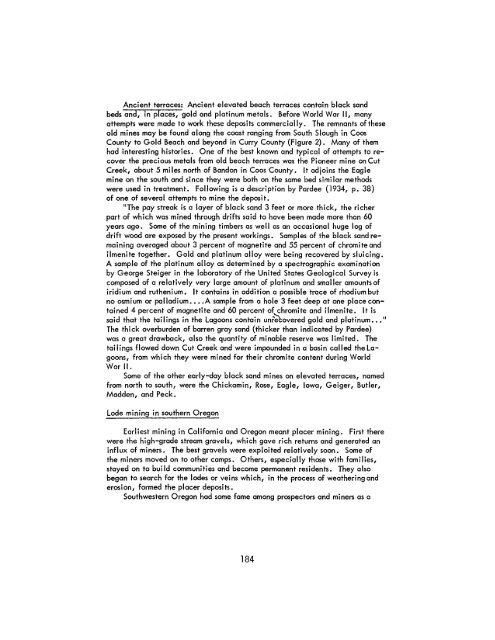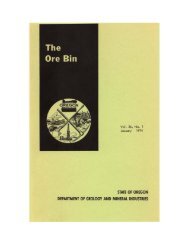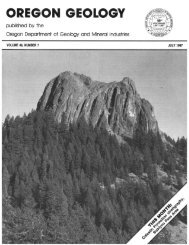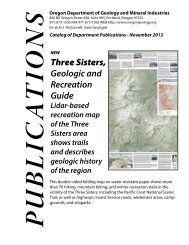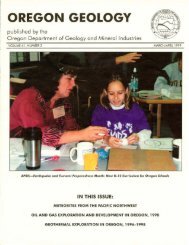The Ore Bin - Oregon Department of Geology and Mineral Industries
The Ore Bin - Oregon Department of Geology and Mineral Industries
The Ore Bin - Oregon Department of Geology and Mineral Industries
Create successful ePaper yourself
Turn your PDF publications into a flip-book with our unique Google optimized e-Paper software.
Ancient terraces: Ancient elevated beach terraces contain black s<strong>and</strong><br />
beds <strong>and</strong>, in places, gold <strong>and</strong> platinum metals. Before World War II, many<br />
attempts were made to work these deposits commercially. <strong>The</strong> remnants <strong>of</strong> these<br />
old mines may be found along the coast ranging from South Slough in Coos<br />
County to Gold Beach <strong>and</strong> beyond in Curry County (Figure 2). Many <strong>of</strong> them<br />
had interesting histories. One <strong>of</strong> the best known <strong>and</strong> typical <strong>of</strong> attempts to recover<br />
the precious metals from old beach terraces was the Pioneer mine on Cut<br />
Creek, about 5 miles north <strong>of</strong> B<strong>and</strong>on in Coos County. It adjoins the Eagle<br />
mine on the south <strong>and</strong> since they were both on the same bed similar methods<br />
were used in treatment. Following is a description by Pardee (1934, p. 38)<br />
<strong>of</strong> one <strong>of</strong> several attempts to mine the deposit.<br />
"<strong>The</strong> pay streak is a layer <strong>of</strong> black s<strong>and</strong> 3 feet or more thick, the richer<br />
part <strong>of</strong> which was mined through drifts said to have been made more than 60<br />
years ago. Some <strong>of</strong> the mining timbers as well as an occasional huge log <strong>of</strong><br />
drift wood are exposed by the present workings. Samples <strong>of</strong> the black s<strong>and</strong> remaining<br />
averaged about 3 percent <strong>of</strong> magnetite <strong>and</strong> 55 percent <strong>of</strong> chromite <strong>and</strong><br />
ilmenite together. Gold <strong>and</strong> platinum alloy were being recovered by sluicing.<br />
A sample <strong>of</strong> the platinum alloy as determined by a spectrographic examination<br />
by George Steiger in the laboratory <strong>of</strong> the United States Geological Survey is<br />
composed <strong>of</strong> a relatively very large amount <strong>of</strong> platinum <strong>and</strong> smaller amounts <strong>of</strong><br />
iridium <strong>and</strong> ruthenium. It contains in addition a possible trace <strong>of</strong> rhodium but<br />
no osmium or palladium ..•. A sample from a hole 3 feet deep at one place contained<br />
4 percent <strong>of</strong> magnetite <strong>and</strong> 60 percent <strong>of</strong> chromite <strong>and</strong> ilmenite. It is<br />
said that the tailings in the Lagoons contain unr'cl:overed gold <strong>and</strong> platinum •.. "<br />
<strong>The</strong> thick overburden <strong>of</strong> barren gray s<strong>and</strong> (thicker than indicated by Pardee)<br />
was a great drawback, also the quantity <strong>of</strong> minable reserve was limited. <strong>The</strong><br />
tailings flowed down Cut Creek <strong>and</strong> were impounded in a basin called the Lagoons,<br />
from which they were mined for their chromite content during World<br />
War II.<br />
Some <strong>of</strong> the other early-day black s<strong>and</strong> mines on elevated terraces, named<br />
from north to south, were the Chickamin, Rose, Eagle, Iowa, Geiger, Butler,<br />
Madden, <strong>and</strong> Peck.<br />
Lode mining in southern <strong>Ore</strong>gon<br />
Earliest mining in California <strong>and</strong> <strong>Ore</strong>gon meant placer mining. First there<br />
were the high-grade stream gravels, which gave rich returns <strong>and</strong> generated an<br />
influx <strong>of</strong> miners. <strong>The</strong> best gravels were exploited relatively soon. Some <strong>of</strong><br />
the miners moved on to other camps. Others, especially those with families,<br />
stayed on to bui Id communities <strong>and</strong> become permanent residents. <strong>The</strong>y also<br />
began to search for the lodes or veins which, in the process <strong>of</strong> weathering <strong>and</strong><br />
erosion, formed the placer deposits.<br />
Southwestern <strong>Ore</strong>gon had some fame among prospectors <strong>and</strong> miners as a<br />
184


